 Trading Stats based on the end of the first set
Trading Stats based on the end of the first set
In the Tennis Profits members’ area there is a ‘Strategies’ section which reveals a selection of tennis trading strategies. One of these strategies is around laying the winner of the first set under certain conditions, and resident trading expert Paul Shires discusses a variety of factors to consider when deciding whether or not to lay the first set winner.
In this article, I am going to look at some key end of first set stats for different players which, when combined with Paul’s insights, have the potential to give us a real trading edge. The stats are based on the last two years up to and including 25 September 2025. The big advantage of using two-year stats is that we tend to get decent sample sizes for individual players; the downside is that those players who are either improving quickly, usually younger up and coming players, or who are on a downward curve may not be well represented by the data. To counter this, I will note yearly stats if there has been a noticeable difference in performance across the two individual years.
Men’s ATP Main Tour
Lost Set 1, Win Set 2 (LS1WS2)
Let’s start by looking at some men’s stats with the focus on players losing the first set. To help give us a benchmark, the ATP tour average for all players in terms of losing the first set but winning the second stands at 36.6%. From a laying the first set winner perspective, therefore, adopting this approach for all matches would see more than a third offer a potential exit opportunity at the end of the second set. Of course, we would need a higher percentage of matches than that to make long term trading profits but it is not a bad starting point.
I want to first consider the top ten ranked players, at the time of writing, as we should expect their percentages to be much higher than the 36.6% tour average. Not surprisingly, the top two players, Carlos Alcaraz and Jannik Sinner, have not lost the first set very often so they have smaller sample sizes. For Alcarez it is 21 matches, Sinner just 14; this compares to third ranked Alexander Zverev whose figure stands at 52 matches. The top two are on another level. Let us look at the LS1WS2 percentages for the whole of the top ten:
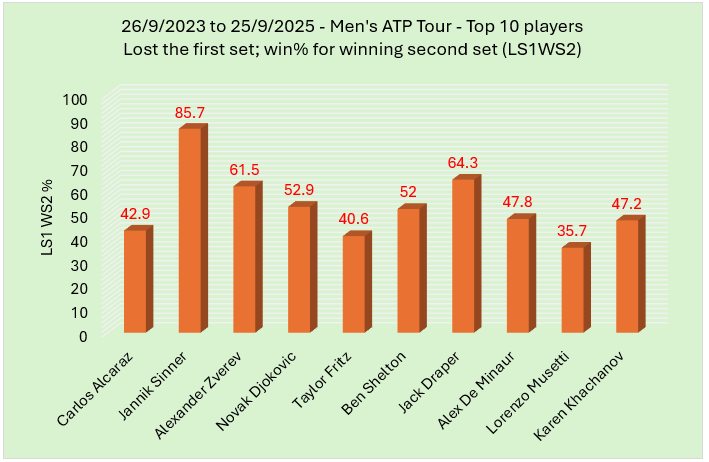
The graph is ordered such that the highest ranked player Carlos Alcaraz is on the far left of the graph, moving from left to right until we reach the tenth ranked player, Karen Khachanov. All bar Lorenzo Musetti have secured percentages higher than the tour average, and the top 10 players combined after losing the first set have won the second set 51.2% of the time. This is roughly 15% above the tour average in absolute terms, but almost 40% relatively (51.2 / 36.6).
As we can see, Jannick Sinner is way above the rest. As stated earlier, in this time frame he lost the first set just 14 times, but in 12 of those matches (85.7%) he came back to win the second set. He is head and shoulders above all players in this regard, not just the top ten, albeit from a smallish sample. Below are the ten players with the highest percentages when it comes to winning the second set having lost the first. Four of the top ten ranked men appear in this list:
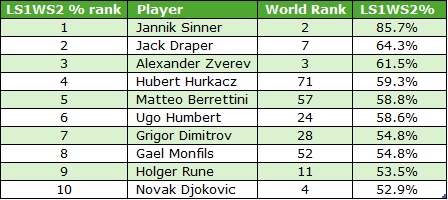
It is interesting to see three players outside the top 50 with high enough LS1WS2 percentages to make this list. In terms of these stats, Hubert Hurkacz has performed well above his official ATP ranking of 71, having particularly impressive figures on outside hard courts and indoor courts. Combining the two together he has recovered the second set 14 times from 20 (70%) when losing the first set. Coincidentally, all three players from outside the top 50 have a career high ranking of number 6 so they have ‘back class’.
Jack Draper, who lies second on the list, has had a particularly impressive last 12 months, recovering the second set eight times from ten (80%) after losing the first. Hopefully, he gets over his current injury issues although he has been dogged in his career so far by them.
There are other players worth noting who have overperformed in terms of their LS1WS2% figures. Here are seven players who caught my eye:

Hamad Medjedovic is a 22yo Serbian who surprised the tennis world when winning the 2023 Next Generation ATP Finals, becoming the lowest ranked winner ever of that event (110). Before this breakthrough his first six titles on the ITF and Challenger Tour were won on clay. Hence it is no surprise perhaps that he has a 58.3% LS1WS2 figure on this slower surface (7 from 12).
On the flip side we have a few players who, based on their world ranking, have under performed when it comes to losing the first set. Three of the top ten make this list:

Carlos Alcaraz is surprisingly lowly ranked (36) using the LS1WS2% ranking method. Based on all his other stats we would expect this figure to be well over 50%. Based on just 21 matches, this is a relatively modest sample, so we need to be cautious: if, say, in his next three matches where he lost the first set, he won the second, then his figures would stand at 12/24 (50%). Percentages can climb (or drop) quickly when the sample sizes are small.
Before moving on there is one player with hugely contrasting figures when we compare his clay LS1WS2% with all other surfaces and that is Sebastian Baez. The graph below shows the difference:
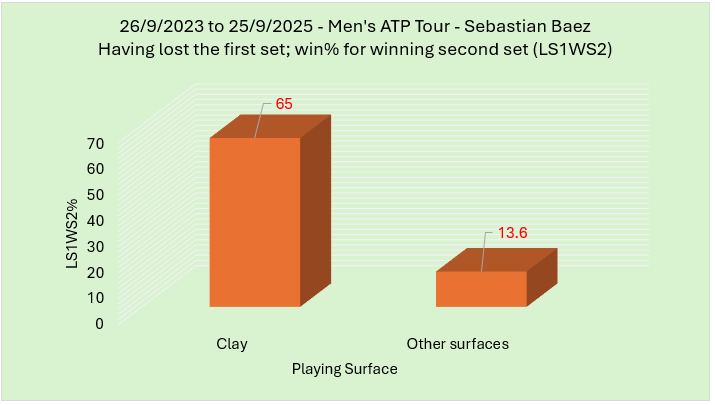
Baez, from Argentina, grew up on the slower clay courts. Six of his seven ATP titles and all six of his Challenger titles were won on clay. In every generation we get a small handful of players who are far better on one surface than the others. He is an excellent example of this.
Lost Set 1, Win Match (LS1WM)
Clearly, these data have strong links with the stats shared already, as in the majority of ATP events (excluding the Grand Slams), to win the match having lost the first set a player needs to win the second set. The benchmark for LS1WM percentages is the ATP tour average again which in this case is 19.7%.
Let me start as I did earlier by looking at the percentages for the top ten ranked players (at the time of writing):
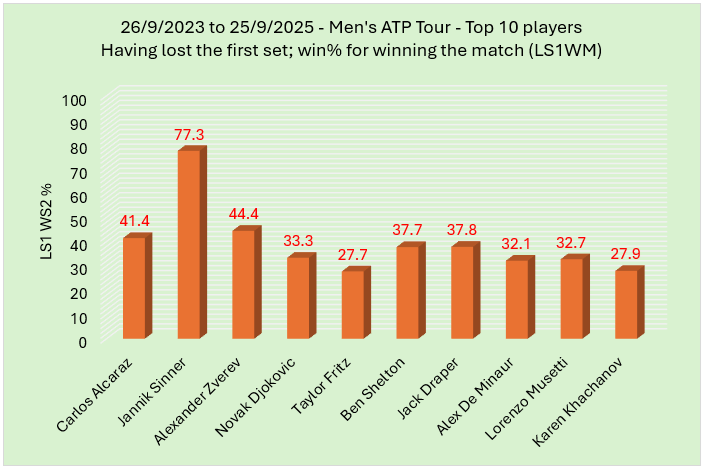
Based on the LS1LS2 figures seen earlier, it will come as no surprise to again see Sinner way out in front. That is an amazing percentage, around four times higher than the tour average. All of the top ten have figures above the tour average and most of them comfortably above. The LS1WM average percentage for the top ten stands at 37.3%.
A look now at the top 10 LS1WM percentages, led not surprisingly by Sinner:
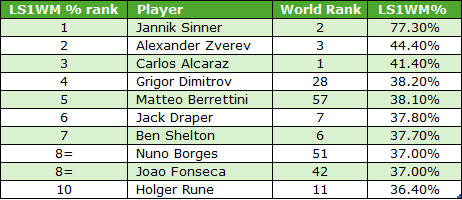
The top three in the world are in the top three spots, albeit in a slightly different order. Indeed, five of the top seven slots are taken up by players world ranked one to seven. I feel this helps to emphasise in part what I was talking about in the previous article where the very best players cope better than the rest when the pressure is on. Losing the first set in an ATP tournament (outside the Slams) means there is no room for error: a loss of either set two or three sees them lose the match.
Let’s look as before at those who have overperformed in terms of their LS1WM% figures. Eight players make this list:
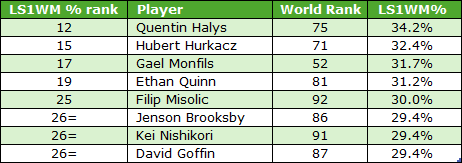
Several players who showed up well in terms of the LS1WS2% stats appear here as would be expected. Hurkacz, Monfils, Quinn, Misolic, Brooksby and Goffin are those players. Onto those players now who have underperformed.
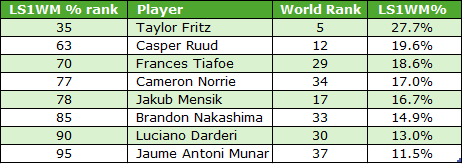
Despite Taylor Fritz’s LS1WM% being well above the ATP tour average, it is quite low in comparison to his world ranking of 5. It is perhaps no huge surprise to see Frances Tiafoe on this list as he has struggled somewhat since hitting his career high ranking of 10 back in June of 2023.
One extra stat for Casper Ruud worth sharing is that in ten indoor matches over the past two years he has failed to come back and win any of them from a set down.
I noted earlier Sebastian Baez’s unusual LS1WS2 splits for clay versus other surfaces. The contrast is just as stark when comparing his LS1WM% splits. On clay he is 42.9% (9 from 21) and on the other surfaces combined is down at just 3.7% (1 from 27).
Women’s WTA Main Tour
Lost Set 1, Win Set 2 (LS1WS2)
Time to look at the same two metrics but on the WTA tour. I will start again by looking at the current top 10 players in terms of losing the first set but winning the second. Again they are ordered left to right by official ranking:
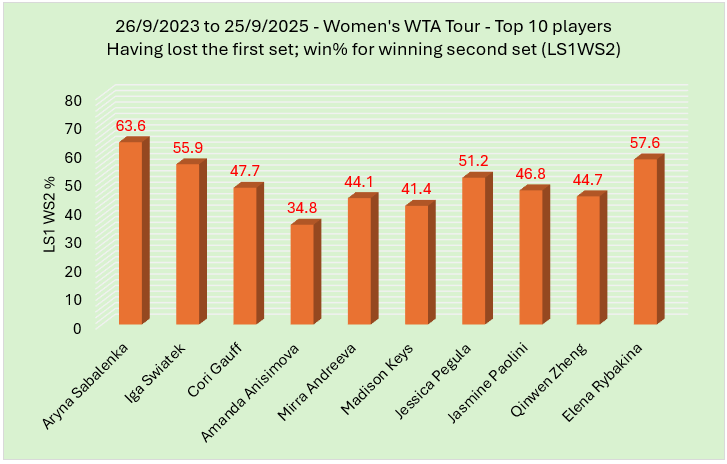
The WTA tour average stands at 33.9% which is 2.7% lower than the men’s average, while the average for the top 10 ranked players is 49.2%, again slightly lower than the men’s figure of 51.2%. That relative differential widens to over 45% between the top ten and the overall average.
World number 1 Aryna Sabalenka has the highest LS1WS2% with a figure of 63.6%. Amanda Anisimova’s percentage is low, and although this year she has powered back up the rankings her record for the past twelve months is still poor at 35.3%.
Below are the ten players with the highest percentages when it comes to winning the second set having lost the first. Four of the top ten ranked players appear in this list:
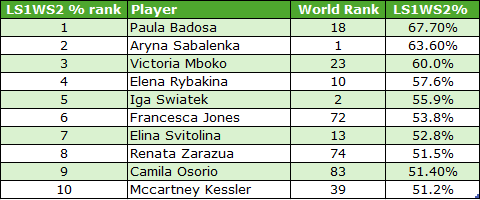
Victoria Mboko and Fran Jones both have small sample sizes and are upwardly mobile talents, but the remaining eight all have at least 30+ matches where they have lost the first set. Paula Badosa tops the list; she has done remarkably well considering her injury struggles in the past few years, and if it wasn’t for those I suspect she would be a top five player again. Camila Osorio has recovered well in particular on clay courts with a 66.7% LS1WS2% figure, thanks to coming back eight times in 12 matches.
A look now at other players who have performed well above their world ranking when it comes to their LS1WS2 percentages.

Ajla Tomljanovic is a better player than her current world ranking of 94 so it is no surprise to see her in this group of players, while 23-year-old Anastasia Zakharova is a player just starting to make her mark on the main tour. As holder of 16 ITF titles she knows how to win and this is perhaps why she as high as 14 on this specific list.
Moving now onto the players who, based on their WTA Ranking, have underperformed when it comes to losing the first set and winning the second:
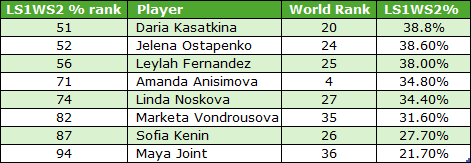
Jelena Ostapenko is what I call a ‘mood’ player; she can play lights out tennis when everything is going right, but can play very poorly when things are going wrong. She definitely underperforms when losing the first set, and especially so on hard courts where her percentage is just 32% (8 from 32).
Lost Set 1, Win Match (LS1WM)
As with the men’s data shared earlier we would expect some correlation with these stats and the LS1WS2 ones. The benchmark is the WTA tour average of 18.6%, again slightly below the men’s figure (19.7%). Let’s start once again with the top ten ranked women:
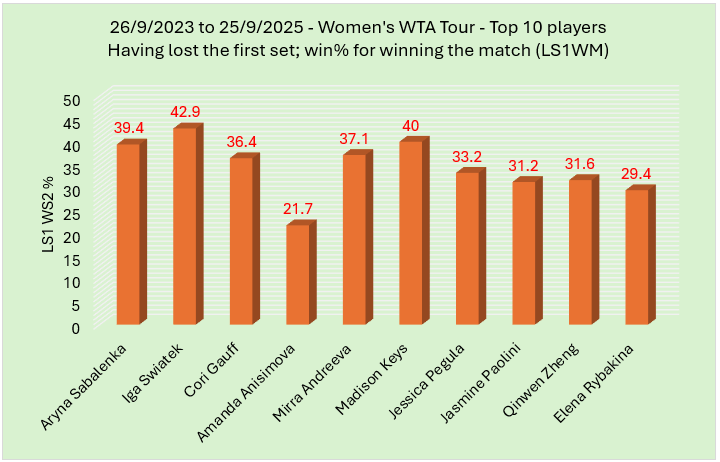
The top 10 ranked players’ LS1WM% averages out at 34.4%, roughly three percentage points lower than the top 10 men. Iga Swiatek has the highest figure in the top ten while the lowest is Amanda Anisimova. Her poor percentage correlates with her low LS1WS2 percentage seen earlier.
A look now at the top 10 LS1WM percentages across the whole tour:
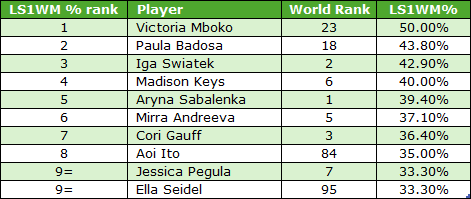
Six of the top ten make the list so we see a similar correlation to the men’s top 10 LS1WM percentages. Badosa and Mboko figure as they did in the LS1WS2 top 10. Lower ranked players Aoi Ito and Ella Seidei are surprising names to see in this list, but clearly they have a good mentality when losing the first set. These two players are likely to go under the radar of most tennis traders under these circumstances and are therefore worth noting.
Let’s look again at those who have overperformed in terms of their LS1WM% figures. Seven ladies make this list:

Galfi, Jones and Ruse are names we saw earlier in a positive light, while we have a few other perhaps lesser-known players that from a trading perspective are ones to consider backing after losing the first set. All players in the table have percentages well above the tour average so they have the potential to offer some value under these circumstances.
Finally, a look at those who have underperformed in terms of LS1WM percentages based on their world ranking:
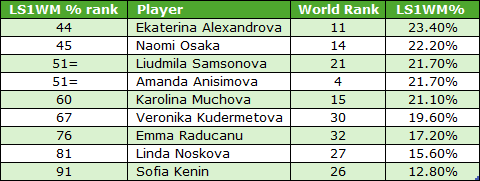
There is a caveat to one player in this list and that is Naomi Osaka. Her overall figures for the last two years are low, as the table shows, but there is a big difference between the most recent 52 weeks and the previous year. Over the past 52 weeks she is on 50%, which actually is the highest figure of all players over the past year! The previous year she was way down on just 5.9% having turned the match around after losing the first set just once in 17 attempts. I mentioned in the introduction that when looking at two-year stats we need to be aware that some players will have significant differences when it comes to their composition. This is a prime example.
There are also some interesting hard-court stats to share. Firstly, Emma Raducanu is 0 from 15 on this surface when it comes to winning matches from a set down. Maya Joint is 0 from 14, Peyton Stearns is 1 from 24 (4.2%) and Tatjana Maria 0 from 27.
**
As we know, the end of the first set is a key entry point for us traders. I hope these stats will help in terms of deciding whether to enter the market or not when this group of players is a set behind.
– DR



Great work Dave.
Thanks Dave!
Do you know the numbers for pre-match favourites only LS1WS2 and LS1WM?
Greets Paul